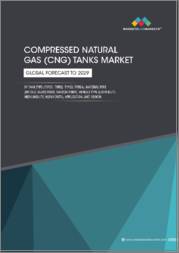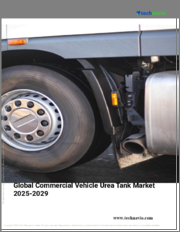
|
시장보고서
상품코드
1621729
자동차 연료 탱크 시장 성장 기회, 성장 촉진요인, 산업 동향 분석 및 예측(2024-2032년)Automotive Fuel Tank Market Opportunity, Growth Drivers, Industry Trend Analysis, and Forecast 2024 - 2032 |
||||||
세계 자동차 연료탱크 시장은 2023년 176억 달러에 달했고, 2024-2032년간 연평균 4.7%의 성장률을 보일 것으로 예측됩니다.
특히 신흥 시장에서의 자동차 산업 성장은 자동차 생산량 증가에 따른 연료탱크 수요를 견인하고 있습니다. 신흥국의 가처분 소득 증가, 도시화, 인프라 개선 등의 요인이 이러한 성장에 기여하고 있습니다. 또한, 차량 공유 서비스 및 차량 운영의 확대는 차량 생산량을 더욱 증가시켜 연료 탱크의 필요성을 더욱 증가시키고 있습니다. 대기오염을 줄이고 기후 변화에 대응하기 위해 전 세계적으로 강화된 배기가스 배출 기준은 연료 탱크의 설계 및 제조 공정에 큰 영향을 미치고 있습니다.
최신 연료 탱크는 증발 배출을 억제하기 위해 첨단 밀폐 시스템과 증기 관리 기술을 탑재하여 개발되고 있습니다. 이러한 규제에 힘입어 제조업체들은 저배출 연료 탱크의 연구개발에 투자하고 있습니다. 신흥 시장에서도 국제적인 환경 기준에 맞추어 이러한 첨단 시스템 채택이 확대되고 있습니다. 배출가스 규제가 강화됨에 따라 자동차 연료탱크 산업은 저배출 기술 혁신의 새로운 기회로 진화하고 있습니다.
용량 측면에서 45-70리터 부문은 2023년 55% 이상의 점유율을 차지하며 2032년에는 130억 달러 이상 시장을 형성할 것으로 예측됩니다. 소비자들은 자동차를 구매할 때 주행거리를 지속적으로 우선시하고 있으며, 이 연료 탱크 용량은 주행거리와 차량 크기의 균형을 제공합니다. 이 부문은 차량 무게와 실내 공간에 큰 영향을 미치지 않고 고속도로에서 장시간 주행할 수 있는 충분한 연료를 공급합니다. 연비가 향상됨에 따라 이 크기의 탱크는 주행거리가 더욱 길어지고 소비자에게 더욱 매력적으로 다가갈 것으로 예상됩니다. 재료 측면에서 플라스틱 연료 탱크는 2032년까지 180억 달러 이상 시장 규모를 형성할 것으로 예상됩니다. 자동차 제조업체들은 연비를 개선하고 배기 가스 규제를 충족시키기 위해 차량 경량화에 점점 더 많은 노력을 기울이고 있습니다.
| 시장 범위 | |
|---|---|
| 시작 연도 | 2023년 |
| 예측 연도 | 2024년-2032년 |
| 시작 금액 | 176억 달러 |
| 예상 금액 | 263억 달러 |
| CAGR | 4.7% |
금속 대체품보다 가벼운 플라스틱 연료 탱크는 이 목표에 크게 기여하고 있습니다. 이러한 추세는 소형차, SUV, 상용차와 같은 차량 부문에서 특히 두드러집니다. 또한 플라스틱은 보다 유연한 설계 옵션이 가능하기 때문에 복잡한 형태와 부품을 연료 탱크 설계에 통합할 수 있습니다. 중국은 2023년 자동차 연료 탱크 시장의 40% 이상을 차지했습니다. 전기자동차의 부상에도 불구하고 내연 기관 차량은 여전히 중국의 주요 부문입니다.
시장 개척은 엄격한 연비 및 배기가스 규제를 충족시키기 위해 고밀도 폴리에틸렌(HDPE) 및 금속과 플라스틱 하이브리드를 사용한 첨단 연료 탱크를 개발하여 시장 성장을 더욱 촉진하고 있습니다.
목차
제1장 조사 방법과 조사 범위
제2장 주요 요약
제3장 산업 인사이트
- 생태계 분석
- 공급업체 상황
- 원료 공급업체
- 자동차 OEM
- 연료 탱크 제조업체
- 기술 integrator
- 최종사용자
- 이익률 분석
- 차별화 기술
- 연료 탱크 설계 AI
- 소음 저감 기술
- 다층 연료 탱크 설계
- 첨단 제조 기술
- 기타
- 주요 뉴스와 이니셔티브
- 규제 상황
- 영향요인
- 성장 촉진요인
- 세계의 자동차 생산 증가
- 차량 경량화에 대한 주목 증가
- 대체연료 차 채택 증가
- 연료 탱크 설계 진보
- 산업 잠재적 리스크와 과제
- 전기자동차에의 시프트 증가
- 연료 적합성 문제
- 성장 촉진요인
- 성장 가능성 분석
- Porter's Five Forces 분석
- PESTEL 분석
제4장 경쟁 구도
- 서론
- 기업 점유율 분석
- 경쟁 포지셔닝 매트릭스
- 전략 전망 매트릭스
제5장 시장 추정·예측 : 용량별, 2021-2032년
- 주요 동향
- 45리터 이하
- 45-70리터
- 70리터 이상
제6장 시장 추정·예측 : 재료별, 2021-2032년
- 주요 동향
- 플라스틱
- 스틸
- 알루미늄
- 복합재료
제7장 시장 추정·예측 : 추진력별, 2021-2032년
- 주요 동향
- 내연기관
- 하이브리드
- 압축천연가스
- 수소
- 기타
제8장 시장 추정·예측 : 차량별, 2021-2032년
- 주요 동향
- 이륜차
- 삼륜차
- 승용차
- 상용차
제9장 시장 추정·예측 : 지역별, 2021-2032년
- 주요 동향
- 북미
- 미국
- 캐나다
- 유럽
- 영국
- 독일
- 프랑스
- 스페인
- 이탈리아
- 러시아
- 북유럽
- 아시아태평양
- 중국
- 인도
- 일본
- 한국
- 뉴질랜드
- 동남아시아
- 라틴아메리카
- 브라질
- 멕시코
- 아르헨티나
- 중동 및 아프리카
- 아랍에미리트
- 남아프리카공화국
- 사우디아라비아
제10장 기업 개요
- Aethra Automotive Systems
- Alpha Racing
- Donghee
- Fuel Total Systems
- Kautex
- Magna International
- Martinrea International
- Motherson Yachiyo Automotive Systems
- OPmobility
- Rochling
- SFS Group
- SKH Group
- SMA Serbatoi
- SRD Holdings
- Stako
- Tata AutoComp Systems
- TI Fluid Systems
- Time Technoplast
- Unipres Corporation
- Yapp Automotive Systems(SDIC Group)
The Global Automotive Fuel Tank Market reached USD 17.6 billion in 2023 and is anticipated to grow at a CAGR of 4.7% between 2024 and 2032. The automotive industry's growth, especially in emerging markets, is driving demand for fuel tanks fueled by increased vehicle production. Factors such as rising disposable incomes, urbanization, and improved infrastructure in developing countries are contributing to this growth. Additionally, the expansion of ride-sharing services and fleet operations is further elevating vehicle production, boosting the need for fuel tanks. Stricter global emissions standards aimed at reducing air pollution and combating climate change are significantly influencing fuel tank design and manufacturing processes.
Modern fuel tanks are being developed with advanced sealing systems and vapor management technologies to control evaporative emissions. This regulatory push is leading manufacturers to invest in research and development for low-emission fuel tanks. Emerging markets are also seeing a growing adoption of these advanced systems, aligning with international environmental standards. As emissions regulations become more stringent, the automotive fuel tank industry is evolving with new opportunities for innovation in low-emission technology.
In terms of capacity, the 45-70 liter segment dominated the market, holding over 55% of the share in 2023, is projected to surpass USD 13 billion by 2032. Consumers continue to prioritize vehicle range when purchasing vehicles, with this fuel tank capacity offering a balance between extended range and vehicle size. This segment provides enough fuel for long highway trips without significantly affecting the vehicle's weight or interior space. As fuel efficiency improves, tanks within this size range are expected to offer an even greater driving range, making them more appealing to consumers. On the material front, plastic fuel tanks are set to exceed USD 18 billion by 2032. Automakers are increasingly focused on reducing vehicle weight to improve fuel efficiency and meet emissions standards.
| Market Scope | |
|---|---|
| Start Year | 2023 |
| Forecast Year | 2024-2032 |
| Start Value | $17.6 Billion |
| Forecast Value | $26.3 Billion |
| CAGR | 4.7% |
Plastic fuel tanks, which are lighter than metal alternatives, contribute significantly to this goal. This trend is particularly prominent in vehicle segments such as compact cars, SUVs, and commercial vehicles. Additionally, plastic allows for more flexible design options, enabling the integration of complex shapes and components into fuel tank designs. China accounted for more than 40% of the automotive fuel tank market in 2023. Despite the rise of electric vehicles, internal combustion engine vehicles remain a key segment in China.
Manufacturers are developing advanced fuel tanks using high-density polyethylene (HDPE) and metal-plastic hybrids to meet stringent fuel economy and emissions regulations, further driving market growth.
Table of Contents
Chapter 1 Methodology & Scope
- 1.1 Research design
- 1.1.1 Research approach
- 1.1.2 Data collection methods
- 1.2 Base estimates and calculations
- 1.2.1 Base year calculation
- 1.2.2 Key trends for market estimates
- 1.3 Forecast model
- 1.4 Primary research & validation
- 1.4.1 Primary sources
- 1.4.2 Data mining sources
- 1.5 Market definitions
Chapter 2 Executive Summary
- 2.1 Industry 360° synopsis, 2021 - 2032
Chapter 3 Industry Insights
- 3.1 Industry ecosystem analysis
- 3.2 Supplier landscape
- 3.2.1 Raw material suppliers
- 3.2.2 Automotive OEM
- 3.2.3 Fuel tank manufacturers
- 3.2.4 Technology integrators
- 3.2.5 End users
- 3.3 Profit margin analysis
- 3.4 Technology differentiators
- 3.4.1 AI in fuel tank design
- 3.4.2 Noise reduction technologies
- 3.4.3 Multi-layer fuel tank designs
- 3.4.4 Advanced manufacturing technologies
- 3.4.5 Others
- 3.5 Key news & initiatives
- 3.6 Regulatory landscape
- 3.7 Impact forces
- 3.7.1 Growth drivers
- 3.7.1.1 Increasing global vehicle production
- 3.7.1.2 Growing focus on vehicle weight reduction
- 3.7.1.3 Increasing adoption of alternate fuel vehicles
- 3.7.1.4 Advancements in fuel tank design
- 3.7.2 Industry pitfalls & challenges
- 3.7.2.1 Growing shift towards electric vehicles
- 3.7.2.2 Fuel compatibility issues
- 3.7.1 Growth drivers
- 3.8 Growth potential analysis
- 3.9 Porter's analysis
- 3.10 PESTEL analysis
Chapter 4 Competitive Landscape, 2023
- 4.1 Introduction
- 4.2 Company market share analysis
- 4.3 Competitive positioning matrix
- 4.4 Strategic outlook matrix
Chapter 5 Market Estimates & Forecast, By Capacity, 2021 - 2032 ($Bn, Units)
- 5.1 Key trends
- 5.2 Less than 45 liters
- 5.3 45-70 liters
- 5.4 More than 70 liters
Chapter 6 Market Estimates & Forecast, By Material, 2021 - 2032 ($Bn, Units)
- 6.1 Key trends
- 6.2 Plastic
- 6.3 Steel
- 6.4 Aluminium
- 6.5 Composite materials
Chapter 7 Market Estimates & Forecast, By Propulsion, 2021 - 2032 ($Bn, Units)
- 7.1 Key trends
- 7.2 Internal combustion engine
- 7.3 Hybrid
- 7.4 Compressed natural gas
- 7.5 Hydrogen
- 7.6 Others
Chapter 8 Market Estimates & Forecast, By Vehicle, 2021 - 2032 ($Bn, Units)
- 8.1 Key trends
- 8.2 Two-wheelers
- 8.3 Three-wheelers
- 8.4 Passenger cars
- 8.5 Commercial vehicle
Chapter 9 Market Estimates & Forecast, By Region, 2021 - 2032 ($Bn, Units)
- 9.1 Key trends
- 9.2 North America
- 9.2.1 U.S.
- 9.2.2 Canada
- 9.3 Europe
- 9.3.1 UK
- 9.3.2 Germany
- 9.3.3 France
- 9.3.4 Spain
- 9.3.5 Italy
- 9.3.6 Russia
- 9.3.7 Nordics
- 9.4 Asia Pacific
- 9.4.1 China
- 9.4.2 India
- 9.4.3 Japan
- 9.4.4 South Korea
- 9.4.5 ANZ
- 9.4.6 Southeast Asia
- 9.5 Latin America
- 9.5.1 Brazil
- 9.5.2 Mexico
- 9.5.3 Argentina
- 9.6 MEA
- 9.6.1 UAE
- 9.6.2 South Africa
- 9.6.3 Saudi Arabia
Chapter 10 Company Profiles
- 10.1 Aethra Automotive Systems
- 10.2 Alpha Racing
- 10.3 Donghee
- 10.4 Fuel Total Systems
- 10.5 Kautex
- 10.6 Magna International
- 10.7 Martinrea International
- 10.8 Motherson Yachiyo Automotive Systems
- 10.9 OPmobility
- 10.10 Rochling
- 10.11 SFS Group
- 10.12 SKH Group
- 10.13 SMA Serbatoi
- 10.14 SRD Holdings
- 10.15 Stako
- 10.16 Tata AutoComp Systems
- 10.17 TI Fluid Systems
- 10.18 Time Technoplast
- 10.19 Unipres Corporation
- 10.20 Yapp Automotive Systems (SDIC Group)



















